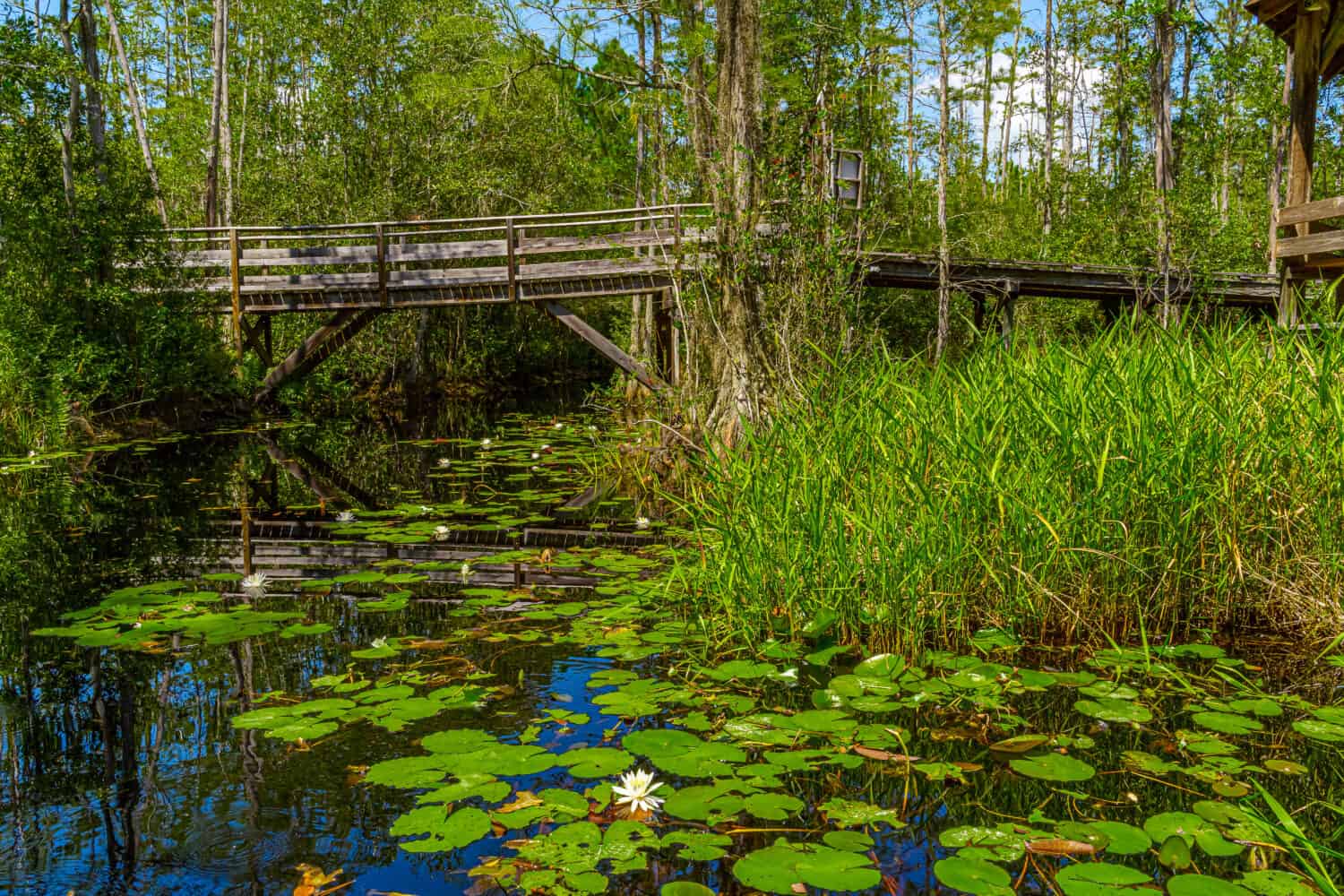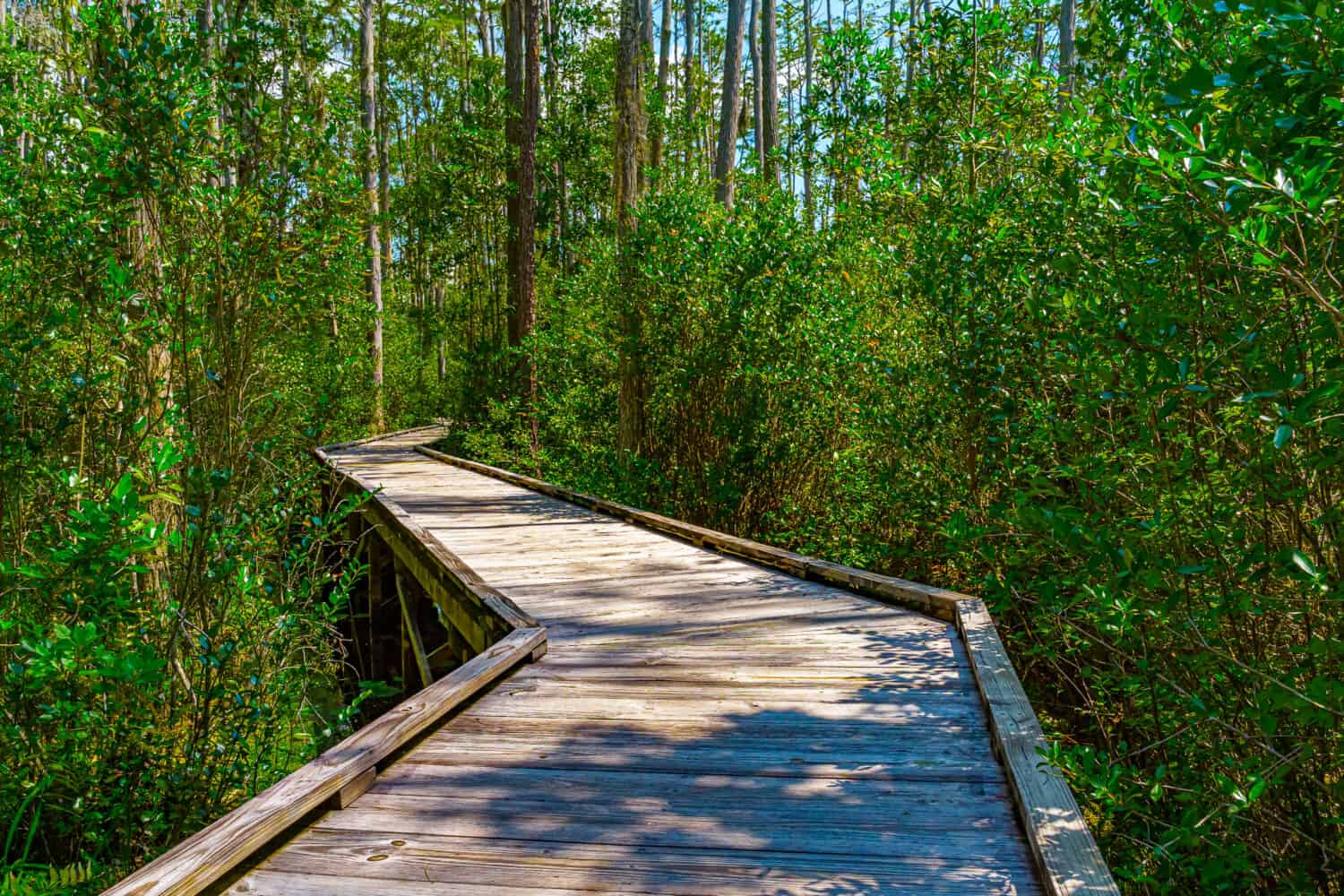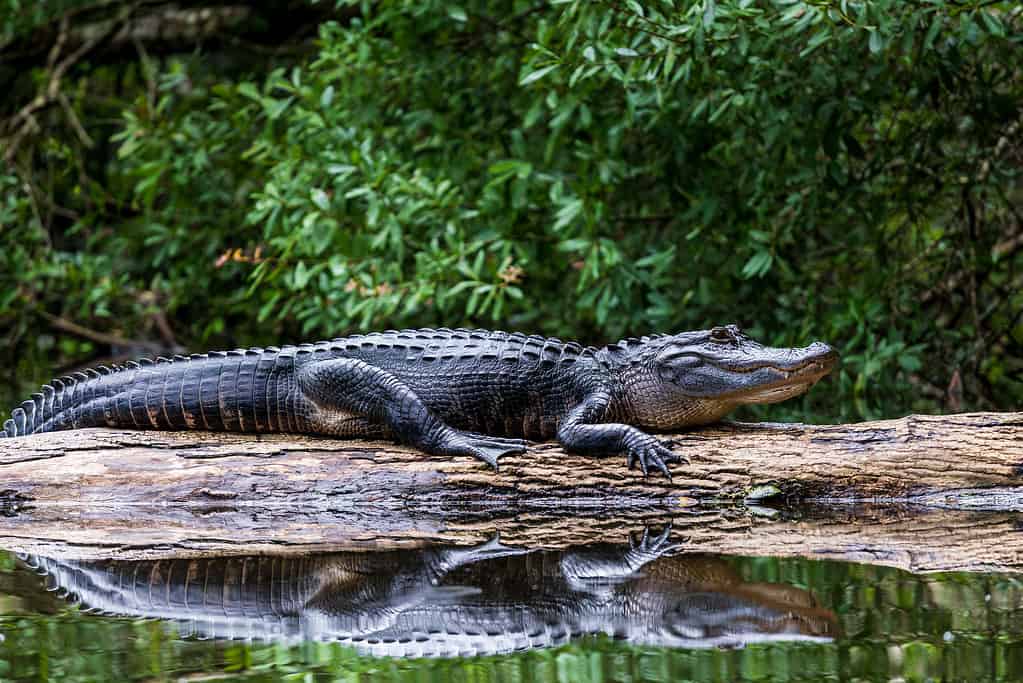
Green lily pads in the Okefenokee Swamp National Wildlife Refuge near Folkston, Georgia
©Bob Pool/Shutterstock.com
Besides serving as a gateway to Florida, the southeastern corner of Georgia doesn’t have a large claim to fame. However, one of the largest freshwater ecosystems can be found in this region, making the area quite popular. Known as the ‘Land of the Trembling Earth’, the Okefenokee Swamp is a large tourist draw to the quiet little corner of the state. More than just what many think of as a swamp, this vast area includes wooded areas for hiking, roads for wildlife viewing, and plenty of outdoor activities. Before jumping into 5 fun reasons to visit the Okefenokee, here are some interesting facts.
Swamp Facts
- Covering 440,000 acres, or 630 square miles, it is the largest blackwater swamp in North America. Also, it is one of the largest intact freshwater ecosystems in the world.
- Even with its massive amount of acreage, it is just 1/3-ish the size of the Florida Everglades.
- The saucer-shaped depression is approximately 25 miles wide, and 40 miles long.
- Mostly residing in Georgia, part of Okefenokee Swamp bleeds into northwest Florida.
- The swamp has three entrances in Georgia: Waycross, Folkston, and Fargo.
- More than 600,000 visitors from up to 46 countries travel to Okefenokee Swamp yearly.
- There are an estimated 10,000-13,000 gators throughout the entire swamp’s acreage.
- Okefenokee is a Native American word that means ‘land of the trembling earth’. This was based simply on the fact that peat deposits covering the swamp floor don’t provide solid footing. Walking here is compared to the feeling of walking on a mattress.
- Two Timucuan villages and Spanish missions existed near the swamp between 1620 and 1656.
- Some white families, known as ‘swampers’, lived on the edge of the Okefenokee Swamp. Creating a home in the swamp as early as 1805, they had cattle, and hogs and maintained small gardens and corn patches.
1. There’s No ‘Off Season’

This bridge connects a hiking trail leading into a wooded area of the Okefenokee Swamp.
©Vadim 777/Shutterstock.com
While each season brings its own highlights and beauty, there is never really a bad time to visit. The south is famous for mild temps in the winter months, so typical ‘winter weather’ is hardly ever an issue at the Okefenokee Swamp.
While any season is manageable, the fall is ideal for a few reasons. First, there are fewer bugs, which always make an outdoor adventure much more enjoyable. Second, the weather is wonderful, with crisp cool temperatures without the summer humidity. And third, the colors of fall are displayed through the flowers, leaves, and shrubs.
For bird lovers, winter is the optimum visit date. This is the time the migratory sandhill cranes arrive, between late November through early February. Winter months can also be opportunities to view the cranes and wading birds.
During this time, the temps are usually pretty mild but colder temperatures do hit the swamp throughout the winter months. This cooler season is between December 1st to February 25th each year. Very rarely does this region see freezing temperatures, as average winter lows are 41 degrees. The coldest month of the year is January, with tops reaching 63 degrees on average.
Spring is not only a beautiful time in the swamp but also the busiest. This season is the most sought-after period for water trail reservations.
For those who don’t like the hot sun beating down, the first three seasons highlighted above are strongly suggested. The best time to avoid visiting is from mid-May until the end of August, due to high temps and biting flies. If you brave the elements and join in the South’s summer fun, be sure to pack the sunblock and bug spray!
2. There are Five Public Entrances
Whether you are in Waycross, Folkston, or Fargo, entering the swamp is easy peasy. Entrance fees are required at each entrance and fees vary at each location. The Okefenokee Swamp has three main entrances as well as two secondary entrances. All are within close driving proximity to visit multiple locations during your trip.
The three main entrances are the Suwannee Canal Recreation Area, the Stephen C. Foster State Park, and the Okefenokee Swamp Park. The Okefenokee Swamp Park is the only location without a secondary entrance.
Fargo
Located near Fargo, the Stephen C. Foster State Park consists of 120 acres within the Okefenokee Swamp and a variety of ways to stay overnight. And, overnight stays are ideal because this state park is listed as an International Dark Sky Park. For stargazers, this is the ideal location for observing constellations and the night sky. There are tent camping options, along with RV and trailer stays, as well as nine cottages available for rent. To travel into the heart of the swamp, there is a 1.5-mile nature trail, along with 25 miles of day-use waterways. Other activities within this park include guided boat tours, fishing, and birdwatching along with canoe, kayak, and fishing boat rentals.
Suwannee Sill Recreation Area, a secondary entrance, is eight miles south of the Stephen C. Foster State Park and is a great location for viewing wildlife and doing some fishing. There is a small boat ramp area great for canoes and small watercraft.
Waycross
Okefenokee Swamp Park is just outside of Waycross, Georgia. Guests to this section of the swamp have plenty of options for wildlife encounters and sightings as well. There are train tours and boat tours available, live animal shows, and a boardwalk that winds into the swamp. This main section of the swamp is located at 5700 Okefenokee Swamp Park Road in Waycross, Georgia 31503. As a private entrance, parking is free as is the entrance into the information center/gift shop area. To trek down the boardwalk, there is a price of admittance.
Folkston

The boardwalk of Okefenokee Swamp Park leads to a 40-foot observation tower, perfect for animal and bird sightings.
©Vadim 777/Shutterstock.com
Okefenokee Adventures in Folkston is the third main entrance, located about 30 south of Waycross. Swamp Island Drive leads visitors into the prairies of the swamp. There are several marked parking spots along the loop for wildlife viewing and hiking trails. A larger parking lot is near the entrance to the old Homestead. Several sheds and storage buildings can be viewed, along with a pioneer home. Guests are allowed to walk up on the front porch, but the doors are locked. Viewing through windows is welcomed.
A wooded path leads from the Chesser Homestead to the Chesser Island Boardwalk. The out-and-back boardwalk is 1.50 miles, with a 40-foot-tall observation tower at the end. Climb to the top for breathtaking views of Seagrove Lake and the open prairies.
Kingfisher Landing is the secondary entrance, about 13 miles north of Folkston. Locals and visitors alike use this location primarily as a boat launch and to gain access to the Green and Red Trails. There are also restrooms in this area.
3. Animals, Animals, Animals

Alligators are the main event throughout the Okefenokee Swamp. They are often the stars of the show.
©Joe Pearl Photography/iStock via Getty Images
Gators
When we think of swamp animals, alligators are probably at the top of the list. At the Okefenokee Swamp, they can be considered an unofficial mascot. After all, it is estimated the swamp houses at least 10,000 gators throughout the 440,000 acres. There are plenty of other animals to see and hear throughout the swamp. Common sightings of raccoons, some wading bird species, as well as endangered species such as the gopher tortoise, indigo snakes, and wood storks. Here’s a breakdown of what visitors can possibly get to see and hear.
Other Reptiles
Including the aforementioned gators, there are 64 species of reptiles within the Okefenokee Swamp. Most likely to be spotted are some harmless water snakes, blue-tailed skinks, and green anoles. The largest venomous species include the cottonmouth, canebrake rattlesnake, as well as the diamondback rattler.
Fish
Throughout the swamp, there are 39 species of fish. Some freshwater fish include bream, bowfin, catfish, and the occasional largemouth bass. There are other gamefish schools as well, ranging from the chain pickerel, warmouth, bullhead catfish, flier, and bowfin.
Fishing is allowed at the main Folkston entrance. The open water lakes and winding water trails are bordered by Cypress trees, providing a great spot to drop a line.
Birds
There are over 230 variations of birds found in the Okefenokee Swamp. Many can be heard while walking the boardwalks and hiking trails. A pair of binoculars atop the observation tower is a great combo for finding birds in the distance. A few types of birds within the swamp include the Swallow-tailed Kite, Barred Owl, Bachman’s Sparrow, Red-cockaded Woodpecker, and the Sandhill Crane.

Sandhill Cranes are commonly spotted within the Okefenokee Swamp.
©Benjamin Tillotson/Shutterstock.com
Except for waterfowl, which have the best birding season in the winter months, all other types of birds offer the best birding seasons year round.
Land Mammals
With over 50 mammals roaming about, chances are good at seeing a handful of varieties. Common sightings are of the Virginia Opossum, armadillo, and the Marsh Rabbit. The Southern Flying Squirrel, beaver, gray fox (with the ability to climb trees), and the Black Bear (look for berries and acorns) are common throughout the swamp. Bobcats are common, while the Florida Panther is mostly a rare sighting. Feral pigs abound, River Otters can be seen along the water, especially during the winter months, and White-tailed Deer can be seen traveling across the prairies, to and from various islands.
Amphibians
There are almost as many amphibian species within the swamp as there are fish. With 37 varieties to choose from, a favorite is sure to be spotted. Chance encounters with these harmless fellows include the squirrel treefrog, lesser siren, northern dwarf siren, two-toed amphiuma, pig frog, and green frog.
4. Outdoor Adventures
Similar to the Okefenokee Swamp Park at Waycross, Okefenokee Adventures in Folkston offers guided boat tours, and bike rentals, plus Jon boat, kayak, and canoe rentals. This location also offers overnight and extended camping trips. The Waycross entrance also offers train rides and as well as live animal shows.
Camping in the Swamp
Camping locations throughout the swamp are plentiful, as there are 70 islands to choose from. Secure a permit online before arrival, bring all your gear and kayak, boat your way to a nice-looking patch of grass, set up camp, and enjoy being one with nature.
Offsite Camping
If you like the idea of camping, but not in the swamp, there is an alternate location that might be a better choice. Pastimes Campground is across from the entrance of the Folkston’s Okefenokee Adventures Refuge. Allowing you to be close by for day activities within the swamp, this pet-friendly campground also is a stargazer’s paradise. Options include eight cabins, 17 campsites, and 48 RV sites.
5. Flora

There are 600 species of plants found within the Okefenokee Swamp.
©leaena/Shutterstock.com
Last but not least, a reason to visit the Okefenokee Swamp is the beauty of the flowers and plants. Throughout the swamp, there are approximately 600 species of plants. The primary species throughout is the Pond-cypress tree. Most were harvested around the early 1900s, but some can still be found measuring over 120 feet tall, and with an age over 400 years.
There are also many ‘meat-eating’ plants such as carnivorous plants: golden trumpet pitcher, hooded pitcher, and parrot pitcher. Each of these has a drooping flower that attracts the insects.
No matter what part of nature you love, or what activities you enjoy in the great outdoors, there is something for everyone at the Okefenokee Swamp. Whether a day trip or a week-long camping experience, the vast land holds plenty to make each day different from the last.
The photo featured at the top of this post is © Nature's Charm/Shutterstock.com
Thank you for reading! Have some feedback for us? Contact the AZ Animals editorial team.







